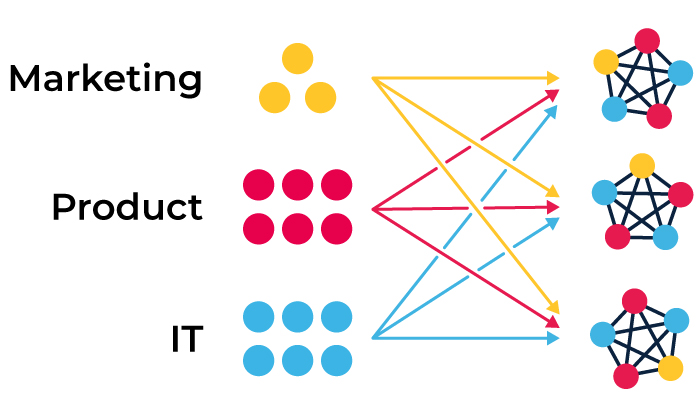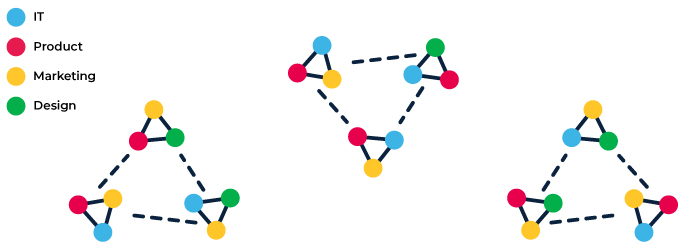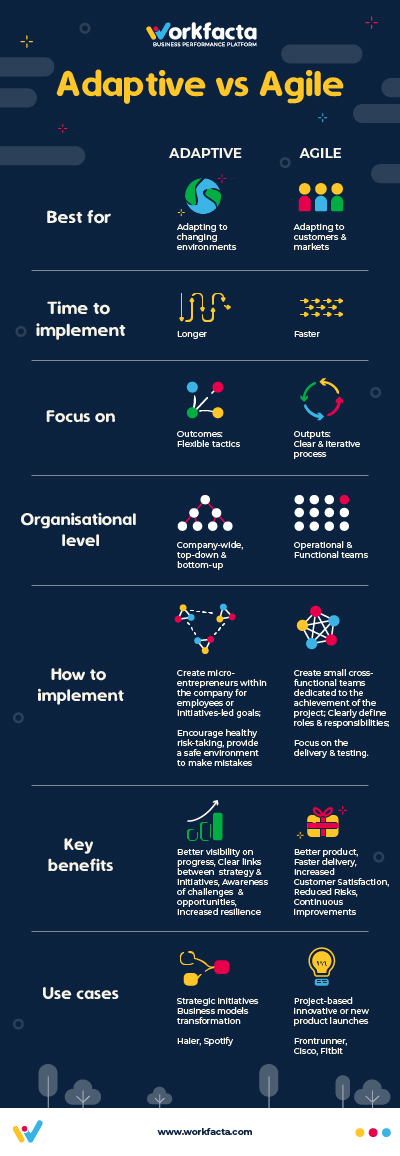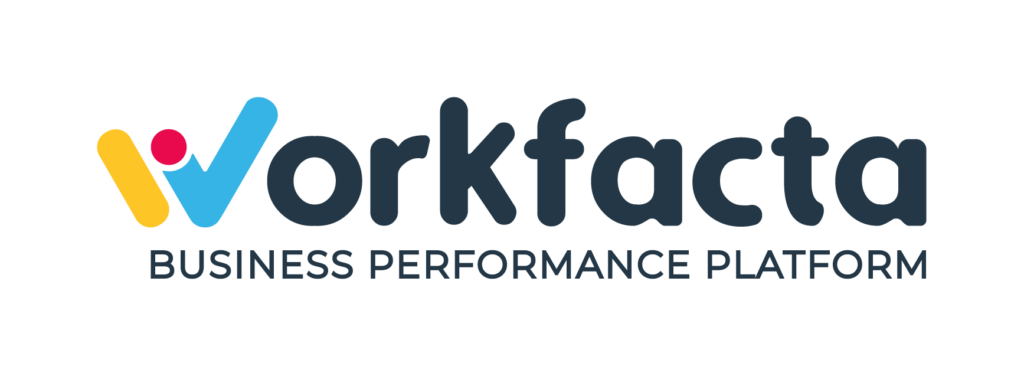
AGILE | ADAPTIVE | PLANNING | STRATEGY | PRODUCTIVITY | TEAM ALIGNMENT
Agile or Adaptive Planning?
What are they, and which one is right for
your business?
your business?
What are they, and which one is right for your business?
 Catherine Lethbridge
Catherine Lethbridge
Published 15/11/2021
The five-year business plan is a thing of the past. With COVID-19, uncertainty and a changing environment have become the norm. Businesses must work with shorter-term plans and be ready to change to keep their competitive advantage to adapt and survive. Successful companies that thrived have factored changes into their planning. Companies that adopted Agile Planning methods moved faster. Companies that chose an Adaptive Planning approach positively transformed their business model to achieve their goals. Living in a world with relentless changes, what makes these planning methods successful, and how do you know which approach is right for your business?
. . .
What is Agile Planning?
Agile focuses on the ability to move quickly and the delivery of outputs. The Agile Methodology, often applied in software development, uses a test and learn approach that helps a project to progress effectively by breaking it into multiple sprints. It considers users’ feedback and is effective in organisations that need to be more innovative. In business planning, adopting Agile means that the company commits to a clear goal, solves problems when they occur and learns from its mistakes. Agile Planning is extremely focused on outputs, and decisions are made swiftly.
Agile Planning is best used for:
- Time-bound projects (such as Cisco’s Subscription Billing Platform implementation)
- New Product launches (including launching new digital insurance products)
- Small teams

Agile organisations: create cross-functional teams
Who used it successfully?
Any small teams and business departments can benefit from Agile Planning. During the COVID-19 crisis, Agile practices became a way for many businesses to manage the impact of the pandemic. Frontrunner, an Australian sports apparel brand, completely rethought its logistics and operation functions to adapt to a disrupted supply chain. A large European insurer managed the launch of one of its products in four weeks, which typically takes months. In both cases, the creation of cross-functional teams was instrumental to their success.
Why should you use it?
Four ways Agile Planning can help your business:
- It encourages collaboration and innovation: adopting Agile creates cross-functional teams that focus on the continuous delivery of improved products and services.
- It promotes continuous learning: a review process is undertaken to identify improvements, which leads to a better product, and better customer satisfaction.
- It accelerates decision-making: roles and responsibilities are clearly defined, reducing frictions when multiple options are on the table.
- It increases the team’s focus, motivation, and success rate: team members have actions that are clearly assigned, efforts are more focused, and solutions are deployed quicker, which creates a feel-good culture that feeds on success.
. . .
What is Adaptive Planning?
Adaptive Planning focuses on outcomes and is open to different pathways to achieving goals. It is designed for businesses to account for uncertainty and requires organisational agility. Put it simply, Adaptive Planning is a way to minimise how wrong you will be by capitalising on opportunities and managing challenges when they arise.
Adaptive Planning is best used for:
- Strategic initiatives (for example, reducing waste as part of a sustainability program, Spotify’s curated podcast playlists)
- Business models transformation (including digitalisation, automation, integrations)
Learn how ADRA Group adapted to the pandemic and achieved incredible milestones.
Read the Case Study
Read the Case Study

Adaptive organisations: a network of cross-functional teams
Who used it successfully?
During the COVID-19 pandemic, many companies have used Adaptive Planning to pivot and continue to achieve the outcomes they want. The champion of Adaptive Planning is undoubtedly Haier. The company has successfully adapted its business and prepared for new opportunities by nurturing and enabling micro-entrepreneurs rather than keeping old school structures that slow down executions. To quickly adapt to the pandemic, Haier leveraged digital technologies and embedded a culture of listening to the customers first. This results in shorter development cycles and faster decision-making.
Why should you use it?
Four ways Adaptive Planning can help your business:
- Everyone in the company becomes a strategic thinker: teams think about outcomes rather than outputs; instead of focusing on doing it right, teams focus on producing an outcome.
- There is room to make mistakes and say no: thinking about outcomes over outputs means that there is a possibility of changing the strategy.
- The business can recover from failures: prioritising an iterative approach to planning means that the company works on a recurring rhythm and improves as a team, not seeking perfection but learning and improving.
- The ability to change and adapt becomes a competitive advantage in times of uncertainty; a focus on learning and iterating means that teams are ready to pivot faster.
. . .
Do you need both?
Agile and Adaptive Planning share some similarities: both agree that sticking to a static planning approach is outdated and advocate for learning as you execute.
The fundamental differences are:
> Agile is more effective at an operational level – where responding quickly to customers’ preferences is key to customer satisfaction and retention. Create cross-functional teams dedicated to projects and product launches.
> Adaptive is best implemented at an organisational level – where every player can have an input in the strategy and the business’s ability to adapt to new environments. Transform your business model by enabling teams to be micro-entrepreneurs for company-wide initiatives. Create a network of cross-functional teams.
> Agile is faster to execute
Agile Planning is more reactive and process-driven but more innovative: you can raise ideas along the way, take risks in a safe environment, and it’s faster to implement. However, it assumes that speed is always the correct answer and prioritises doing over strategic thinking.
> Adaptive builds resilience in the business
Adaptive Planning is less rigid: it intends to build agile organisational mindsets over processes. It’s a continuous learning activity where everyone is involved in the strategy. Adaptive Planning takes longer to implement but is more flexible in a changing environment because it has less bureaucracy. Adaptive Planning invests in simplicity, but it requires more effort, a healthy level of trust in your team’s abilities, and keeping a vigilant eye against unnecessary complexity.
Workfacta empowers organisations to implement Agile Planning.
Building agility in your business will pay in the long-term and pave the way to an Adaptive Planning mindset.

Scaling agility for adaptiveness
. . .
The bottom line
Both approaches can be used concurrently. Use Agile Planning for small teams and projects that require frequent reviews to encourage continuous and incremental improvements. For larger teams and more complex goals, consider a long-term approach by embedding Adaptive Planning into your organisation. This approach simplifies strategy and allows teams to create their ways to reach business outcomes.
Choose the right tool to implement these step changes.
Be clear about your organisation’s goals, meet regularly to communicate, align objectives and identify bottlenecks to solve. If you are starting in Agile or Adaptive, choosing the right tool to implement these methodologies plays a decisive role in the success of your plan. A Business Performance Platform, such as Workfacta, can ease your team into adopting an agile way of working.
Workfacta’s fully integrated platform has a built-in execution workflow to empower your teams to set goals and track their progress in real-time. With Workfacta, your teams always align to changing priorities, with a clear understanding of the reasons behind the evolving environment.
Download full size poster

At Workfacta, we work across many industries to deliver business growth at every stage of the company’s journey.
Learn more about how Workfacta can support your business goals. Contact us now for a chat or organise an obligation-free demo with our Workfacta expert.


